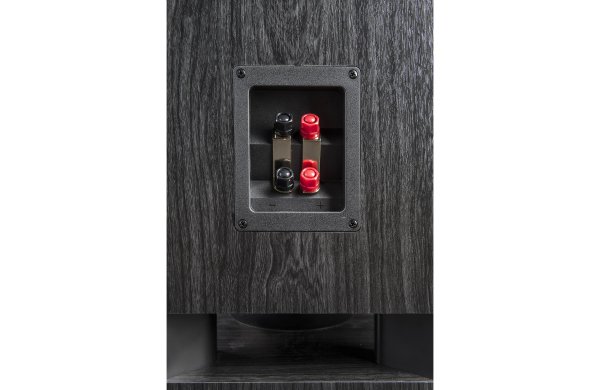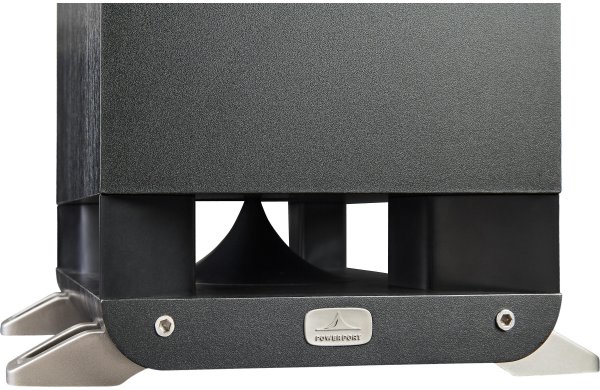In this review, we will be comparing ES50 and S50, two Passive Floor-standing speakers by Polk Audio
Let's have a brief look at the main features
of Polk ES50 and Polk S50 first before getting into our more
detailed comparison.
Polk ES50 Key Specs
- 2-way Design
- 1" Soft-Dome Tweeter
- 2 x 5.25" Mica-reinforced polypropylene Woofer
- 38-40k Hz Frequency Response
- 88 dB Sensitivity
- Impedance: 8ohms
- Power Range:40-200watts
- Weight:14.50kg
- Dimensions (H x W x D): 951.0" x 7-1/2" x 11-1/16"( 951.0 x 191.0 x 281.0mm )
Polk S50 Key Specs
- 2-way Design
- 1" Dome Tweeter
- 2 x 5.25" Mica-reinforced polypropylene Woofer
- 33-40k Hz Frequency Response
- 89 dB Sensitivity
- Impedance: 8ohms
- Power Range:20-150watts
- Weight:14.50kg
- Dimensions (H x W x D): 951.0" x 10-5/16" x 11-1/16"( 951.0 x 262.0 x 281.0mm )
What size room are the Polk ES50 and Polk S50 speakers good for?
The size of the room in which you are planning to use these loudspeakers is an important decision
factor. Here we have compared their suitability to various sizes of environments considering their size
and max power parameters:
| Listening Environment* |
Polk ES50 |
Polk S50 |
| Near-field |
Bad |
Bad |
| Small Room |
Poor |
Poor |
| Mid-size Room |
Good |
Good |
| Large Room |
Good |
Good |
| Very Large Room |
Poor |
Poor |
(* Approximate Room sizes: Small < 100sq. ft / 9 m2,
Mid-size: 100-220 sq. ft / 9-20 m2, Large 220-400 sq. ft / 20-36 m2, Very Large: >
400 sq. ft / 36 m2.
Average Floor Height: 9" / 2.7m. Typical room sizes differ from country to country, and the actual
listening experience changes depending on floor height, room shape, surface materials, listening
position, speaker locations, etc.)
In the following sections, we will get into more detail in order to better understand how the Polk ES50 and Polk S50 compare and hopefully end up with enough arguments to decide which one of these loudspeakers is the better choice for you.
**This post contains affiliate links, and I will be compensated if you make a purchase after clicking
through my links. As an Amazon Associate I earn from qualifying purchases.
Drivers
Both ES50 and S50 are 2-way speakers.
| Driver |
Polk ES50 |
Polk S50 |
|
Driver Setup
|
2-way
|
2-way
|
|
Tweeter
|
1-inch
|
1-inch
|
|
Midrange
|
- |
- |
|
Woofer
|
2 x 5.25-inch
|
2 x 5.25-inch
|
ES50 features a 1" Terylene High-Res Soft-Dome Tweeter and 2 x 5.25" Mica-reinforced polypropylene Woofer with a Crossover frequency at 2500Hz. On the other hand, the S50 features a 1" Terylene Dome Tweeter and 2 x 5.25" Mica-reinforced polypropylene Woofer with a Crossover frequency at 2500Hz.
Frequency Response
ES50 has a frequency range of 38-40k Hz whereas S50 has a frequency range of 33-40k Hz. With a minimum frequency of 33Hz, the S50 can go significantly deeper on the low side and provide stronger bass compared to the ES50's min frequency of 38Hz.
Below graphs depict how these two speakers compare with the max, min and average values of the Min and Max Frequencies of other speakers in the Floor-standing class in our database.
Low Frequency
Floor-standing Speakers
High Frequency
Floor-standing Speakers
None of these speakers achieves full range experience which is commonly agreed as 20Hz-20kHz. In order to achieve lower lows / deeper bass, we recommend you pair these with a subwoofer. Visit our Powered Subwoofers section to find out more about the available options.
Impedance and Sensitivity
ES50 and S50 have the same Impedance of 8 ohms but where they differ is the sensitivity levels. ES50 sensitivity is rated at 88 dB and the S50's is at 89 dB. This 1 dB difference makes the Polk S50 a more sensitive speaker compared to Polk ES50, hence will play louder with the same amount of watts.
Sensitivity
Floor-standing Speakers
Power Range
Power
range is the range of input power in watts RMS that a loudspeaker is designed to handle. While using
an amplifier within this range ensures the nominal performance , inputting a power that is higher than the
max wattage can result in a damaged speaker.
ES50 can handle a max power of 200 watts RMS from the amp the whereas S50 has a max power handling value of 150 watts RMS, 50 watts less than the ES50.
Keep in mind that a higher max power handling value doesn't necessarily make that a louder speaker
compared to a lower max handling speaker. Loudness or the sound level is also impacted by parameters
such as Impedance, sensitivity and system efficiencies.
Input Type and Bi-Amping / Bi-Wiring
Both ES50 and S50 features dual binding post speaker terminals for bi-amping or bi-wiring.
 Polk S50's 5-way post terminals allows Bi-amping or bi-wiring
Polk S50's 5-way post terminals allows Bi-amping or bi-wiring
Cabinet Type and Port Position
Both ES50 and S50 have bottom firing ports.
 Polk S50 Port
Polk S50 Port
Physical Specs
Size of a speaker can sometimes become an important decision factor due to space constraints or in some cases purely for esthetic reasons. In this section, we are going to compare Polk ES50's and Polk S50's external dimensions. Polk ES50 has external dimensions of 951.0 x 191.0 x 281.0mm ( 37-7/16 x 7-1/2 x 11-1/16inch) whereas Polk S50 has external dimensions of 951.0 x 262.0 x 281.0mm ( 37-7/16 x 10-5/16 x 11-1/16inch) .
Base Surface Area Comparison
Base surface area of a loudspeaker may become a determining factor when the space in your room or desk is limited.
The base surface area of the Polk ES50 is approximately 536.7cm2 / 83.2inch2 and base area of the Polk S50 is approximately 736.2cm2 / 114.1inch2. The ES50 requires 27% less surface area than the S50 which gives it a small advantage on placement in tight spaces.
Weight Comparison The weight of a loudspeaker can become an important factor if you need to move and reposition the unit often. Weight of a speaker can also "sometimes" be an indicator of the rigidity of the enclosure and the quality of the internal components used. The Polk ES50 weighs 14.50kg / 31.9lbs and the Polk S50 weighs 14.50kg / 31.9lbs.
Here is a comparison of how ES50 and S50's weights compare with the average, max and min weights in Passive Floor-standing class.
Weight
All Floor-standing Speakers
What's in the Box of Polk ES50?
Here are the items that are included inside the box of ES50:
Floorstanding loudspeakerGrille (attached)4 Feet (pre-installed)Owners ManualOnline Product Registration
What's in the Box of Polk S50?
Here are the items that come with the S50:
Floorstanding loudspeakerGrille (attached)4 Feet (pre-installed)Owners ManualOnline Product Registration
 Max Input Power Max Input Power |
200 watts
vs
150 watts
|
Handle more power from your amplifier |
 Base Surface Area Base Surface Area |
536cm2
vs
736cm2
|
Takes less floor space |
 Sensitivity Sensitivity |
89 dB
vs
88 dB
|
Play louder with same amount of amplification power |
 Low Frequency Response Low Frequency Response |
33 Hz
vs
38 Hz
|
Generates deeper bass |
| General |
Polk Audio Signature Elite ES50 |
Polk Audio Signature S50 |
| Brand |
Polk Audio |
Polk Audio |
| Speaker Type |
Floor-standing speaker |
Floor-standing speaker |
| Power Range |
40-200 watts |
20-150 watts |
| Sensitivity |
88 dB |
89 dB |
| Impedance |
8 ohms |
8 ohms |
| Frequency Response |
38-40k Hz |
33-40k Hz |
Drivers |
|
|
| Woofer Quantity |
2 |
2 |
| Woofer Size |
5.25" |
5.25" |
| Woofer Composition |
Mica-reinforced polypropylene |
Mica-reinforced polypropylene |
| Woofer Surround Material |
Butyl rubber |
Butyl rubber |
| Tweeter Size |
1" |
1" |
| Tweeter Type |
Soft-Dome |
Dome |
| Aimable Tweeter |
No |
No |
| Midrange Driver |
No |
No |
| Crossover Frequency |
2500Hz |
2500Hz |
| Firing Direction |
bottom |
bottom |
Physical Specs |
|
|
| Height |
951.0mm (37.4") |
951.0mm (37.4") |
| Width |
191.0mm (7.5") |
262.0mm (10.3") |
| Depth |
281.0mm (11.1") |
281.0mm (11.1") |
| Weight |
14.50kg (31.9lbs) |
14.50kg (31.9lbs) |
| Enclosure |
Bass Reflex |
Bass Reflex |
| Finish |
MDF, Wood-grain vinyl |
Meddite MDF |
| Available Colors |
Black |
Black |
| Grille |
Yes |
Yes |
| Moisture Resistancy |
No |
No |
Connections |
|
|
| Biamp Inputs |
Yes |
Yes |
Other |
|
|
| Parts Warranty |
5 Years |
5 Years |
| Labor Warranty |
5 Years |
5 Years |